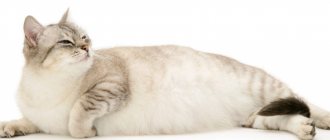The essence of allergies, causes and their classification
An allergy is a complex reactive process in a cat’s body when an ordinary and completely safe substance is perceived as something foreign and dangerous. This substance is called an allergen.
Immunity against allergens works in such a way that the “harmful” substance is not immediately eliminated from the body, but first an inflammatory process is provoked around it. Next, a substance such as histamine is released into the blood, which, acting on certain cellular receptors, becomes the culprit for the entire spectrum of clinical manifestations of the reactive state. A feature of all such reactions is the individual set of allergens and the unpredictability of symptoms.
Allergies can be caused by absolutely any substance:
- food (each cat has its own individual allergens);
- chemicals (shampoos, powders, cleaning agents and detergents, etc.);
- dust, mold, pollen;
- medicines;
- cat litter;
- saliva and waste products of blood-sucking insects and skin parasites;
- hair of other animals, dander or other gland secretions;
- the body's own cells.
general information
Otitis is inflammation of the ears . In this case, the inflammatory process is initiated by an allergy. How is this possible? It's quite simple. In the case of allergies, when tireless mast cells begin to release histamine into the blood, vascular permeability increases and other negative effects occur. All this can lead to the fact that the natural microflora of the ear canal is seriously changing. This makes it possible for pathogenic and conditionally pathogenic microflora (including fungi) to effectively establish a “bridgehead”, causing secondary infections.
A more severe variant is also possible when, due to increased vascular porosity, lymphocytes begin to “migrate” en masse in the ear tissue. Infiltration occurs (lymphocytic or neutrophilic). Often such a process is a harbinger of an autoimmune pathology.
What can be the triggering factor that causes an allergy? Much. Oddly enough, it is not pollen that holds the “palm”, which constantly provokes the development of allergies in people. Much more dangerous are ordinary household chemicals, as well as cosmetics and some components of medicines and feed. Practicing veterinarians in all countries of the world have long noticed that the risk of this is much higher in cats that constantly eat exclusively dry food. I would also like to remind those who like to keep their “fluffy” perfectly clean that for bathing animals they should use only (!) hypoallergenic shampoos approved by the veterinary association.
Remember! If you practice self-prescribing medications for your pet, please read the instructions. The same vaccines and polyvalent serums often cause allergies; you should always have antihistamines and a veterinarian’s phone number on hand.
In some cases, pathology occurs through no fault of the owners. Other cat breeds (British, Persian, Siamese, etc.) are very predisposed to developing allergies. The blame for this lies with unscrupulous breeders who do not promptly exclude “defective” animals from the reproduction process.
Types of allergic manifestations
Atopic
This is an idiosyncrasy or allergy to any allergens exposed in any of the following possible ways:
- food allergies in cats;
- reaction to medications;
- reaction to dust, pollen, mold.
Infectious
Occurs on substances that are produced in the body during the life of fungi, viruses or bacteria):
- fungal;
- bacterial;
- viral.
Parasitic-insect
This is a reaction to saliva and the vital activity of cutaneous or intradermal parasites, as well as worms.
Chemical
This is an allergy to care products, household chemicals, cat litter, etc.
According to the method of exposure to allergens, the classification is as follows:
- contact (by direct contact with the allergen);
- respiratory (by inhalation);
- autoimmune (internal allergic reaction to the body’s own cells).
Treatment of allergies in cats
The veterinarian prescribes both antiallergic medications and those that relieve complex symptoms.
It is necessary to immediately relieve itching and inflammation on the pet’s skin, and treat scratched wounds .
It is important to calm the cat , because skin diseases lead to severe irritation.
Each remedy is selected individually , since the animal may have a negative reaction to medications.
- Antihistamines for cats are necessary for all types of allergies; they soothe, reduce skin manifestations, swelling, and irritation.
- To restore good skin condition, a special healing and soothing ointment . If there are wounds, the product should also have a disinfectant effect. To prevent your cat from licking medications from the skin, you need to put a special collar on her during treatment.
- If you have a food allergy, it is important to follow a diet that includes neutral and fresh foods . The diet is needed for a long time, and the provoking product is excluded in the future, so as not to cause food allergies again. You can identify a negative reaction to a product if you replace chicken with fish or store-bought fermented milk products with cottage cheese or home-made yogurt. Most often, proteins of animal or plant origin become allergens in a cat’s body.
- a large number of dry food of different brands on sale , and it is this type of food that is leading in the field of food allergies. You need to carefully monitor your pet’s reaction to a new food; when the first signs of illness appear, you should change the brand of food and try a different composition.
- Antihistamine and corticosteroid tablets are prescribed for atopic dermatitis. A medicine that completely cures this disease has not yet been created, so it is important to regularly monitor the manifestations of the disease. Atopy is especially difficult to manifest in spring and autumn; you need to help your cat survive such seasons. Dermatitis may also be accompanied by a bacterial or fungal infection .
- With atopy, the skin first becomes dry, severe itching appears, debilitating the pet . In places where scratching occurs, the wounds even turn into wet ulcers, complicated by infections. Any factor can provoke an allergy - a new product, some kind of grass, a powder that was used to wash the bedding. The disease cannot be cured, but the cat’s symptoms should be alleviated, itching should be relieved with medications, and ointment should be applied to the wounds.
ATTENTION! Peeling of your cat's paw pads may indicate an allergic reaction to the litter in the litter box.
For all breeds, veterinarians recommend choosing odorless litter with small particles . It is advisable to read on the packaging what kind of wood this product is made from, because a reaction to a certain type of wood is possible. Peeling of the pads may also indicate an allergy to household chemicals or washing powder .
Skin irritation in a kitten or adult animal caused by insects is also a health problem. You can protect your pet from fleas using a special collar and anti-flea shampoo . Swelling and even difficulty breathing in a cat after a wasp or bee sting are possible. In this case, you need to quickly give your pet antihistamines and sedatives.
At home, with proper treatment and following the doctor's recommendations, it is not difficult to cure allergies. Manufacturers produce tablets, ointments, drops. You can choose the form of medication that is more convenient for treatment .
Symptoms of allergic manifestations
Regardless of the type of allergy, common signs of the body's reaction to allergens are:
- redness of the skin or skin rash of various locations;
- itching, visible scratching, baldness, swelling of certain areas of the body;
- sneezing, discharge from the nose and/or eyes;
- peeling of paw pads, eczema in the interdigital space;
- dyspnea;
- vomit;
- sometimes increased body temperature;
- possible swelling of the respiratory tract;
- anaphylactic shock (in very rare cases).
An allergy in a cat can manifest itself as one symptom, or perhaps as a whole symptom complex of several phenomena. Reactions are observed both immediately after interaction with allergens and after some time (which usually makes diagnosis difficult).
Features of symptoms for various types of allergies:
|
|
| classic signs of allergy accompany the underlying fungal, viral, bacterial or helminthic disease. |
|
|
|
|
| damage mainly to the respiratory tract (discharge from the nose and eyes, swelling of the larynx, shortness of breath). |
|
|
|
|
Main types of allergies
Protein components perceived by the animal’s body as foreign are usually divided into two groups – exogenous and endogenous.
Exogenous allergens are those that enter the body from the environment. Various foods, medications, pathogenic bacterial and fungal microorganisms that penetrate the body through the respiratory tract, epidermis or digestive system can cause allergies.
Endogenous allergens are produced by the pet’s own body. This type of allergic reaction, provoked by internal biological systems, is diagnosed quite rarely. It occurs as a result of complex biochemical changes that provoke the breakdown of cellular structures and tissues. As a result of the malfunction, the immune system recognizes its own healthy cells as foreign and begins to attack them.
There are also a number of factors that provoke the onset of a specific reaction in the body. Among them are:
- predisposition at the genetic level;
- violation of the general environmental situation;
- intolerance to certain substances by animals at the individual level;
- toxic substances injected by blood-sucking insects that parasitize the animal’s skin;
- pollen of flowering plants;
- household and street dust;
- household chemicals.
The most commonly diagnosed types of allergies in cats in veterinary clinical practice are:
- Food allergies. Allergies to food in cats occur more often than other types of specific reactions of the body. The owner of the animal may not suspect for a long time that his pet is experiencing pathological processes in the body. This is primarily due to the fact that food allergies develop quite slowly, without making themselves felt for a long time. Cats are less likely to be allergic to chicken than to beef, pork and river fish. Food allergies can be caused not only by animal fats, but also by plant proteins. Due to the fact that the threshold of sensitivity to the allergen is different for all animals, the manifestation of food allergy symptoms may occur several weeks or months after eating one type of food. The reaction develops when the amount of allergen in the bloodstream begins to exceed the norm.
- Flea allergy. Often the cause of a pet's constant itching is a reaction to flea bites. Some cats tolerate bites normally, while others experience inflammatory processes on the skin, characterized by hyperemia and other serious damage, including the formation of ulcers. Flea allergies are provoked by toxic substances contained in the saliva of ectoparasites. During the injection of saliva during a bite, toxic substances enter the cat's systemic bloodstream, which can cause serious imbalances in the body's balance.
- Atopic dermatitis . One of the most serious types of allergic reaction, which is chronic. This type of allergy can occur in response to a wide variety of irritants - medications, household chemicals, street dust, gases and pollen. Allergy to wood filler in a cat also refers to an atomic (chronic) type of disease. It is difficult to identify a foreign agent in a timely manner, so the animal continues to be in contact with the pathogen for a long time. During the stage of exacerbation of allergic dermatitis, the cat itches severely, the skin becomes red and swollen, and weeping eczema appears on the body. As a result of severe scratching, as a rule, pathogenic bacterial microflora is added, complicating the course of the disease and further treatment. It is worth noting that there is no complete cure for atopic dermatitis. Treatment of the pathology is based on eliminating the main symptoms that cause discomfort to the pet.
The main signs of allergies in cats can be seen in the photo
| Flea allergic dermatitis | Allergy tests |
| Atopic dermatitis | Hives |
| Autoimmune pemphigus foliaceus | Allergic lacrimation |
| Autoimmune lupus erythematosus | Contact allergy to detergents |
| Food allergies | Allergy to meat protein |
Features of allergy diagnosis
The diagnosis of “allergy” can only be made by a veterinarian after a personal examination and interview with the animal owner. This disease very successfully disguises itself as many other infectious and internal non-communicable diseases, so only a specialist will be able to differentiate one from the other.
As a rule, cats are not subject to allergy testing. The process is quite expensive and not always informative. Usually performed under general anesthesia, because It is impossible to introduce up to 20 allergens intradermally to an animal without additional effort. Substances included in the anesthesia come into contact with reactive test allergens, showing a false local reaction. Those. the test shows an allergy to something that in fact is not.
There are also no special tests for mustachioed pets, and in practice human test kits are used. Considering the peculiarities of the course of allergic reactions in humans and cats, the likelihood of false results is also very high.
Determining the source of an allergy is carried out exclusively experimentally by the method of exclusion. In this case, all potential allergens are consistently excluded from the cat’s environment until the true cause of the body’s increased sensitivity is identified. This method works great for food allergies.
With seasonal allergies, the source of the reaction is often not looked for at all. If it is noticed that signs of hypersensitivity to something appear once a year for a certain period, then for this period of time it is enough to give antihistamines until the allergen disappears on its own after this period.
Diagnosis of allergies
Only a doctor can say that a cat has an allergy, because often the same symptoms indicate completely different diseases. For example, a cat may have itchy skin and hair loss, but in fact it turns out that the pet needs fatty acids or has pain in its internal organs, etc.
There are no tests that could confirm the presence of an allergy. It is not even possible to find out through research what type of allergy a cat is suffering from. Dermatologists-veterinarians conduct only one diagnostic test - a method to exclude possible allergens. But even this seemingly simple diagnosis is not as simple as it seems at first glance and requires a specialized approach. Therefore, you should not do a “favor” for your pet and make a diagnosis based on personal conclusions; this is a serious illness.
Treatment of allergic (atopic) dermatitis
Eliminating the cause or contact with the cause
Drug treatment will be ineffective if the allergen continues to affect the body. This point usually coincides with preventive measures for the occurrence of allergies, depending on the substances that cause the reaction:
Dust |
|
Mold |
|
Pollen |
|
Cutaneous blood-sucking parasites |
|
Household chemicals |
|
Application of local therapy
As a local antiallergic agent in cats, the use of only shampoos with hydrocortisone is justified. The effect is short-term, but immediate.
The use of ointments with hydrocortisone is justified only in the presence of itching and in small, hard-to-reach areas for licking. Ointments have virtually no adverse reactions due to the fact that they are practically not absorbed into the blood.
Prescription of biotin (vitamin B7) and preparations containing it
It has been proven that this vitamin in combination with omega fatty acids gives a noticeable effect in eliminating allergic dry skin, itching and seborrhea. With long-term use of the biotin + fatty acid complex by a cat in combination with antihistamines and diet, the need for steroids is significantly reduced.
Antihistamines
They are used as emergency aid and for long-term use to eliminate allergic symptoms or reduce their intensity. The dosage is always calculated individually.
Steroids
This group of drugs for systemic use is used in extreme cases, when all possible methods have been tried, but the effect is minimal or completely absent. Corticosteroids have many contraindications and side effects for cats, so it is important to follow the exact dosages and administration schedules that will be prescribed by your veterinarian. It is best to use injectable steroids (flumethasone, betamethasone, dexamethasone, methylprednisolone).
As for atopic dermatitis, unfortunately, it cannot be completely cured. All therapeutic measures are aimed at maximizing the relief of the animal’s condition and reducing the number of exacerbations. Those. this pathology is controllable. The treatment scheme is similar to the treatment of ordinary allergic dermatitis, only it is carried out almost constantly throughout the animal’s life.
Treatment of food allergies
- Eliminating the cause. After determining what type of product the cat is allergic to, it will have to be excluded forever.
- Consumption of a complex of fatty acids + biotin.
- Use of antihistamines.
- The use of steroids for food allergies is indicated when there is no relief in symptoms after all possible treatments. Until the cause is identified, it is usually not prescribed.
Treatment of infectious, parasitic and insect allergies
- Treatment of primary infectious disease. Before you begin direct treatment of allergies, you need to cure primary fungal, infectious or parasitic diseases. Treatment of the primary disease will be considered the elimination of the cause of the allergy.
- Destruction of blood-sucking parasites not only on the cat, but also in the premises where it lives.
- Deworming.
- Antihistamine therapy.
Drugs for allergies in cats (a brief overview of systemic antihistamines)
Any antihistamine has its own exact dosage, exceeding which turns the medicine into a substance harmful to the cat with a lot of adverse reactions. This is the main reason why such medications should only be prescribed by a veterinarian.
Along with veterinary antihistamines, human drugs are effectively used for treatment according to long-developed and effectively implemented regimens.
Veterinary:
Used for allergic dermatitis. Prohibited for diabetes mellitus in cats, pregnant women, heart or kidney pathologies. Do not use for a long time due to the peculiarities of the glucogenic effect (increases blood sugar levels). Intramuscularly at 0.25-0.5 ml/head. every 24-48 hours |
Bravegil (up to 180 rub./amp or up to 120 rub./10 tablets)Widely used for all types of cat allergies. It is administered intramuscularly or given orally in tablet form. Slightly manifests itself in drowsiness. Not used during pregnancy. Dosage: 0.015-0.02 mg/kg once or twice a day (every 12-24 hours) (regardless of the route of administration). Can be used for a long time. |
It perfectly relieves allergic manifestations on a par with diphenhydramine, but has a longer lasting effect. Slightly causes drowsiness in cats. It is administered intramuscularly. Do not use for pregnant individuals. Apply 0.015-0.02 mg/kg twice a day after 12 hours. |
Human:
Effect: antihistamine, analgesic, sedative and hypnotic. The dosage is selected for each animal strictly individually, because It can have completely different effects on different cats, even in the same dosage. It is administered intramuscularly in an amount of 0.02-0.04 ml per 1 animal, in tablets orally the dosage is 1.5-2 more. Maximum twice a day for a week. |
Most often used for allergic reactions to insect bites. There is a hypnotic effect. The action is similar to diphenhydramine. Do not use in lactating animals or during pregnancy. It is forbidden to administer simultaneously with antipyretics. Orally at the rate of 1-4 mg of the drug, without mixing with food. You can repeat no earlier than after 8-12 hours. |
It has an antiallergic, psychotropic, sedative effect, suppresses the emetic effect. Relaxes smooth muscles, dilates bronchi and relieves pain (part of the piperazine range of drugs). Does not provoke addiction. Give orally at a dose of 5-10 mg/cat, repeated after 8-12 hours. |
Chlorpheniramine maleate (RUB 125-500)Works well on feline allergic dermatitis and urticaria. It is better to administer intramuscularly, because when it gets on the surface of the skin, it provokes a local irritant effect. When used orally, combine with or after feeding to reduce stomach irritation. Do not combine with alkaloids. Not suitable for long-term use - only for relief of acute increased individual reactions and no longer than 3 days. Dosage: 1-2 ml/animal intramuscularly or 2-4 ml/animal orally every day or 12 hours. |
Clemastine (Tavegil) (110-220 RUR/pack)Perfectly eliminates allergic symptoms in cats such as sneezing, runny nose and watery eyes. It has a long action time. It enhances the sedative effect of sedatives, so any drug combinations are not recommended. Side effects: diarrhea, thirst, lethargy or increased activity. The dosage does not depend on the weight of the animal: ½ tab. every 12 or 24 hours. |
Classification of allergic reactions in cats
Interesting! There are two types of allergies: food and non-food. But these are only the main types of allergic reactions with corresponding symptoms and treatment.
Food allergies
A food allergy is caused by a cat's hypersensitivity to a specific food product or food component. Often, allergies in cats are caused by protein, which is found in large quantities in chicken meat, dairy products, eggs, vegetables, and grains.
If proteins are added to dry or wet food, the owner should be carefully monitored to ensure that allergy symptoms do not appear.
An allergy to food from a certain brand may occur. In this case, the allergic reaction makes itself felt with symptoms of dysfunction of the digestive system - impaired bowel movements or vomiting attacks.
If treatment is required, cats are prescribed herbal medications with caution, because an allergic reaction to this type of medication is also possible.
Article on the topic: Allergic cough in a child - symptoms and treatment with folk remedies
Allergies in cats, food
Non-food allergies
Non-food allergies are often the result of the bite of parasitic insects - fleas, lice and stinging representatives of insect fauna - mosquitoes, bees, wasps and others.
Note! Fleas bite your cat more than 200 times a day.
In this case, the saliva of insects, especially fleas, contains a protein that causes an allergy in the animal, manifested by symptoms of flea dermatitis - the site of the bites itches unbearably - this promotes the release of biologically active compounds.
If your cat is outdoors, you may be allergic to the bites of stinging animals - snakes, ticks and other living creatures. Often the cause of allergies is changing cat litter. In this case, the cat refuses to use the toilet properly.
Allergies in cats, non-food











